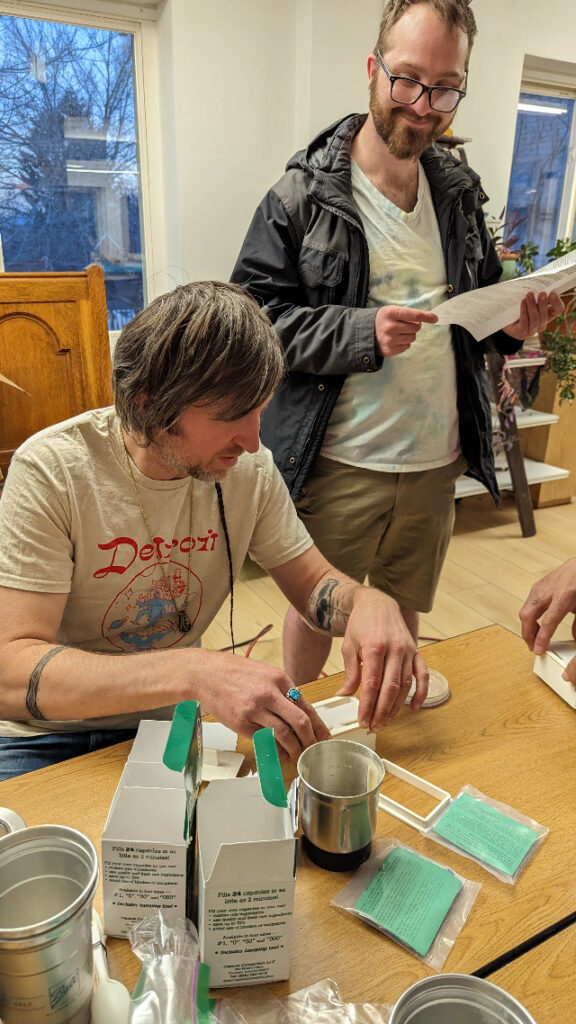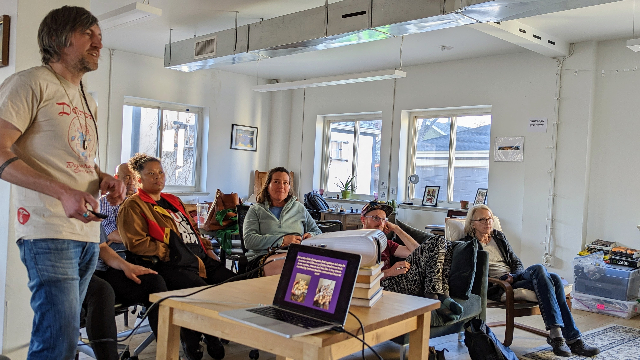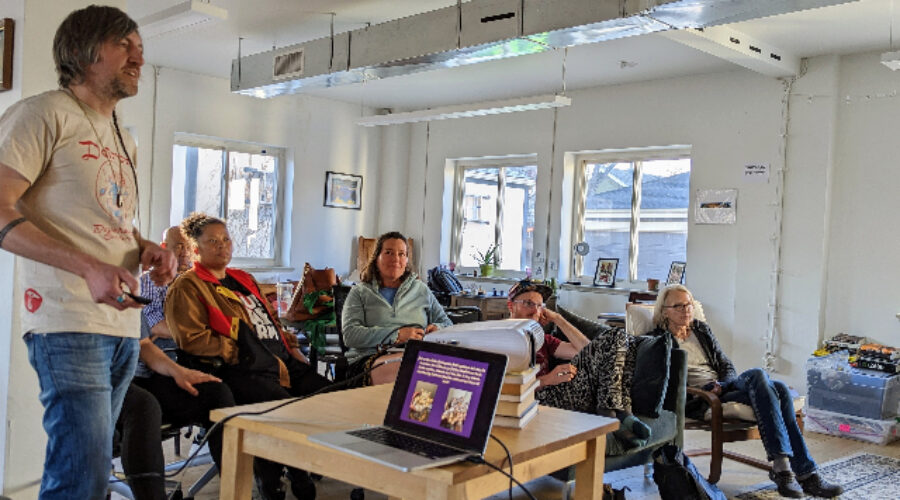At Denver’s Microdose Mondays, Magic Mushrooms are a Legal Gift
In the quiet Northside neighborhood of Denver, in a 130-year-old Church, ten or so people have gathered over the last three Mondays. They sit in chairs for a Keynote presentation. It’s about how to stay safe while using microdoses of psilocybin mushrooms — as well as the history and culture of them. Attendees pay $30 for the class known as Microdose Mondays.
Then, at a long table with bags of dried psilocybin mushrooms, they grind the mushrooms, encapsulate the powder, and put 24 in a bag. Which is a month’s worth of microdoses. The arrangement is a way to explore a nook in Colorado’s new laws around psychedelics. The laws make it lawful for people to sell psychedelic education, but not psychedelics. So the teacher, Travis Tyler Fluck, says the mushrooms are a gift.
RELATED: How to Microdose Shrooms Effectively
Decriminalization and Its Benefits
In more than 20 cities, states and counties — from Ann Arbor to Somerville, MA, to Santa Cruz, CA…and a few places in between, some psychedelics and other drugs are decriminalized or legalized. Colorado legalized mushrooms for personal use in a vote in November.
In most of these decriminalized places, it’s not a crime – or a very minor one – to grow mushrooms and give them away. From Vancouver to Washington, D.C. many are gifting with the same workaround that Denver’s Microdosing Mondays uses. Sell education, gift the mushrooms. Many gifters are starting with gifting small doses – microdoses – not large doses.
A web search and social media suggest online sellers seem more likely to sell microdoses than large doses. Vancouver’s Medicinal Mushroom Dispensary, for example, sells whole mushrooms, but often suggests folks start with micros. Hosts of ayahausca ceremonies in Colorado are not selling jugs of aya tea, but bags of mushroom microdoses. And at least one church in Denver holds ceremonies not with 3 grams of mushrooms, but .2.
Exciting news: Two states have legalized psilocybin therapy for the first time ever. Click here to get on the waiting list for Oregon psilocybin therapy. And click here to get on the waiting list for Colorado psilocybin therapy.

RELATED: The Fadiman Microdosing Protocol vs the Stamets Stack
Mushroom Microdosing is Easy
Thousands of people report microdosing helped them concentrate, feel flow, and feel happier, with few negative side effects. Many scientific studies, on the other hand, claim microdoses are just placebos.
If advocates believe in mushrooms, and think they’re helpful, why not give out huge doses, which clearly have an effect? That seemed to be the motivation in the 1960s, during North America’s first encounter with mushrooms. Back then, almost no one thought to take a microdose. The point was to turn on, see something new, and radically alter your perception of the world.
Jakobien Van Der Weijden, co-founder of the Microdosing Institute in the Netherlands, says macrodosing is not safe or effective for everyone. Meanwhile, microdosing has a lower entry barrier. And many people who have done both have found that “less is more.”
“We acknowledge the value of both macro and microdosing,” she says. “Folks can feel a subtle change, rather than doing a ceremony/session and then return hoping to somehow integrate the learnings from an ineffable experience.”
RELATED: Macrodosing vs. Microdosing: Understanding What Makes Them Different

Microdose Mondays
Travis Tyler Fluck agrees. He organizes and puts on the Microdose Mondays, part of a group called the Denver Mushroom Cooperative. (Fluck is pronounced not like luck but like book. Flook.) Fluck is a 43-year-old jewelry maker with a house full of crystals and a single braid on one side of his head. He’s one of the best mushroom growers in the country.
Fluck was one of the main forces behind the decriminalization of mushrooms in Denver in 2019, a world first. Fluck sometimes takes up to 17 grams at a time. And since decriminalization, Fluck has had lawful wiggle room to guide friends on heroic doses. He usually doesn’t.
“The first thing that came up after the vote was microdosing,” Fluck says. “We’re dismantling stigmas,” said Fluck. “You won’t lose your mind, it won’t poison you. It’s actually quite the opposite. I just keep getting more excited that this is the first thing that we’re moving on.”
What is a Mushroom Microdose
Microdosing is actually very old. Albert Hofmann — who discovered LSD — liked to take one-third of a dose and hang with friends. Microdosing didn’t catch on until last decade, when a psychedelic researcher named Robert Forte, who learned about microdosing from Hofmann, started telling more people about the idea. One such person was a psychologist named James Fadiman, who spread the word to podcasters and magazines.
A microdose is just enough of a dried powdered mushroom to fit in a small plastic capsule. Typically about one-fifth of a gram. When you swallow the pill, you barely feel the mushroom effects. There’s no wavy walls, no giggles, no encounters with Something Bigger. Microdoses are only one-twentieth of a so-called “heroic” dose, 5 grams. On heroic doses, you can forget what day it is and where your feet are located.

A Toe Dipped in the Water with Microdose Mondays
Fluck has another hope for microdoses, beyond its safety and low barrier to entry. He hopes Microdose Mondays will be a little taste, not only of the medicine itself, but of the subculture that has been doing psychedelics for a long time.
“A big chunk of what I do is remind people from whence this medicine came,” Fluck says. “We’re giving society a taste of us – a microdose of the people who are doing the work with the medicine.”
Psychedelic users sometimes have–though don’t always–a slightly different worldview from the one many mainstream Americans share. A way of looking and acting that has long been caricatured as hippie kumbaya, patchouli, and tree hugging. Or else overly mystical among the Mazatecs and Mayans that use them.
You can see it in Fluck’s worldview he presented to the class. Interests some of his students shared. There was a reverence for Indigenous and Eastern religions and a nudge toward community. He said:
- All beings are connected.
- We should treat nature the way we would like to be treated.
- There is “magick” in the world.
- You are medicine.
Happy Students
The students in Fluck’s class seemed to talk away content. They pocketed 24 capsules with .05 grams each. Fluck’s microdoses are tested in the lab to contain 1 mg of psilocybin, the most active chemical in mushrooms. (He uses a strain he calls Shiva Lingam. The strain is more often called strain Penis Envy, but Fluck says the mushrooms themselves told him they find “Penis Envy” vulgar.)
“He made the barrier to entry really low,” said Aaron Orsini, who attended a class. Orsini said he felt “empowered.” He and other students even exchanged phone numbers at the end of class, so they could call later to check up on each other, to make sure they were integrating the classroom lessons, which had cost them $30, and the mushrooms, which were gifts.
RELATED: Divinity for the Non-religious: How Shroom Churches Offer Meaning




Robert Justice
November 27, 2023 at 6:31 pmhow do I sign up for Monday night training